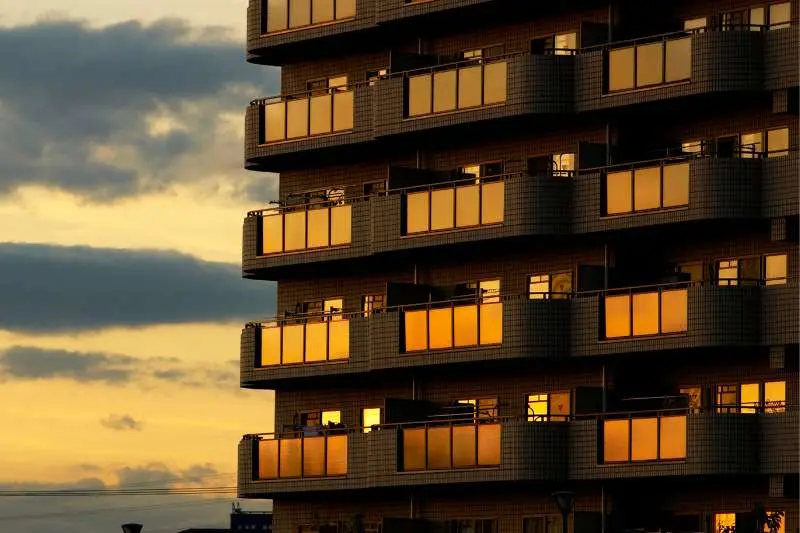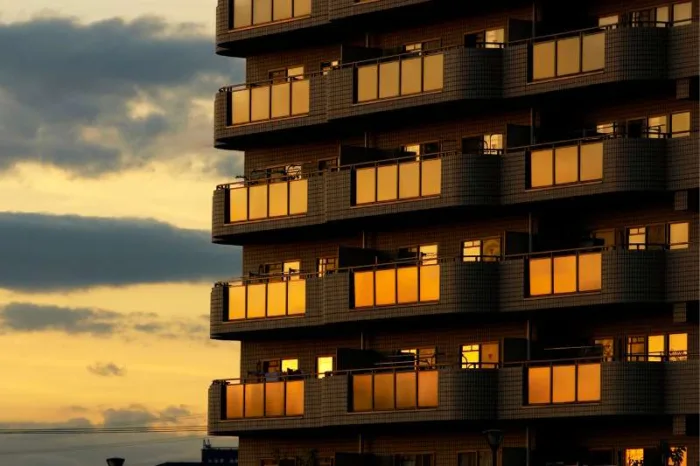Key takeaways
- A high-rise apartment is a residential building that exceeds a certain height.
- Aside from building height, the biggest differences between high-rise and low-rise apartments are their design limitations, location, and infrastructure.
- Residents of high-rise apartments want rooftop terraces, pools, spas, pet-friendly amenities, fitness centers, sports areas, and modern access control.
- The benefits of investing in high-rise development are efficient land use, more housing, the potential for higher returns, sustainable building, and a diversified investment portfolio.
- The drawbacks of investing in high-rise apartments are high construction costs, a lengthy development process, more maintenance, and a negative environmental impact.

High-rise apartments are one of many types of multifamily development projects available to investors. While there is a lot of opportunity for high-rises, they also pose unique challenges and limitations.
With that said, this blog details everything you should know about high-rise development. You’ll learn what a high-rise apartment is, how it differs from other apartments, and which amenities high-rise residents want. Most importantly, you’ll find the pros and cons of developing high-rise flats.
This post covers:
- What is a high-rise apartment?
- What’s the difference between high-rise and low-rise living?
- High-rise apartment amenities residents want
- What are the pros and cons of high-rise flats?
What is a high-rise apartment?
A high-rise apartment is a residential building that reaches a minimum height requirement.
The residential units commonly found in high-rise apartments are extremely diverse, ranging anywhere from penthouses and luxury suites to three-bedroom units and studios.
As for the height of the building, there is no universally accepted minimum height requirement for high-rise apartments. However, most municipalities refer to the National Fire Protection Association’s (NFPA) definition.
The NAFP definition of a high-rise building is as follows:
“High-rise buildings are defined by NFPA 1 and NFPA 101 buildings where the floor of an occupiable story is greater than 75 ft above the lowest level of fire department vehicle access. When looking at your local requirements, it is important to verify how your jurisdiction defines a high-rise building as many jurisdictions may modify the definition.”
Learn how the real estate cycle works:
How much are high rise apartments?
The price of high rise apartments depends on location, but they tend to be more expensive than mid-rise and low-rise or garden-style apartments. For example, a standard 1-bedroom high rise apartment in Los Angeles, California may cost around $4,000 – $5,000 per month, while a similar unit in San Antonio, Texas may cost closer to $2,000 – $3,000.
Why are high rise apartments so expensive?
High-rise buildings tend to be more expensive because:
- They offer more amenities or higher-quality amenities.
- There are better views from higher levels.
- High-rises tend to be located in more desirable or more expensive areas.
- They require more intensive and constant upkeep.
How many floors is a high-rise?
There is no universally defined number of stories a building must exceed to classify as a high-rise. Rather, the minimum is established by local jurisdictions and municipalities. So, it’s best to research your city or county regulations to learn how buildings are labeled high-rises locally.
However, if you follow the NFPA’s definition of a high-rise building, a 75-foot building is approximately five to seven stories, depending on the floor-to-ceiling height.
But building classification can vary widely depending on your area, as some may consider a five to seven-story building a mid-rise apartment. Of course, high-rise apartments can be built much taller, reaching well over 12 stories.
What is the meaning of a luxury building?
High-rise apartments are often referred to as “Luxury buildings,” meaning they provide residents with a higher-than-average quality of living and luxury apartment amenities.
Luxury high-rise apartments will often have features like:
- Newly renovated interiors.
- Modern and spacious kitchens.
- Spa-like bathrooms.
- State-of-the-art gyms.
- Balconies or patios.
- Activities and entertainment for residents.
What’s the difference between high-rise and low-rise living?
The difference between high-rise and low-rise living is the structure of the building and the surrounding area.
High-rise apartments are primarily constructed from concrete, steel, and glass. These high-density housing structures are severely limited in terms of design because they’re located in urban environments, limiting their horizontal space. The limitations of design creep into individual units as well. Most high-rise apartments stick to only a few different layouts; some simply use one throughout.
Conversely, low-rise apartments, also known as walk-up apartments, use the same materials as high-rise buildings in addition to wood, brick, and natural stone. Low-rise apartments are primarily found in lower-density areas, often suburbs or smaller cities. With more space available, low-rise apartments feature more diverse apartment layouts.
Let’s take a closer look at the difference between these types of buildings:
High-rise apartment amenities residents want
With many high-rise flats deemed as “luxury apartments,” it’s essential for your building to have amenities that support such a label.
Some high-rise apartment amenities to consider include:
- Rooftop terrace. High-rise apartments are built amongst bustling urban landscapes, so private outdoor areas will be hard to find. A rooftop terrace provides residents with a relaxing, comfortable space away from the chaos of the city.
- Pool and spa. Resort-style pools and spas are inviting amenities for residents looking to unwind and shed some stress. Saunas, hot tubs, and similar facilities make it easy for residents to practice self-care.
- Pet-friendly amenities. No one wants to leave their furry friend behind when apartment hunting. That’s why modern residents demand pet-friendly amenities, such as dog parks and grooming centers.
- Fitness center. Similar to pools and spas, fitness centers help residents maintain their health and well-being. Residents want a fully-equipped gym to visit so they can stay in shape without having to leave the property.
- Sports areas. Fitness is essential, but residents want to integrate physical activity into the sports they love. Basketball, pickleball, tennis, volleyball, and even bowling are great sports areas to consider adding to your high-rise flats.
- Modern access control. Residents want to feel safe and secure, so a modern access control system is the best way to satisfy those desires. Mobile access control systems are ideal as they allow residents to use their smartphones to access the areas they need. Plus, property staff can remotely manage the system from a browser-based dashboard or the mobile app.
What are the pros and cons of high-rise flats?
High-rise flats are considered luxury apartments, attracting higher-income residents, which could be an opportunity that’s profitable for real estate investing beginners and experts alike. Nonetheless, just like with all real estate development opportunities, developing high-rise apartments has its pros and cons. So, it’s critical you weigh the good and bad before developing or investing in high-rise living.
Pros of high-rise development
- Land use. In high-density areas like city centers, available land is sparse. High-rise apartments use the little amount of land left effectively by building vertically. In turn, high-rise buildings have a smaller footprint on land use while housing more residents.
- Increased units. High-rise apartments can house significantly more residents than walk-up apartments, multiplying their income potential.
- Higher returns. Demand for housing is only increasing as city populations swell. So, developing high-rise apartments for the growing population can boost property value. Not to mention, high-rise apartments attract higher-income residents, allowing you to charge more per square foot.
- Sustainable. High-rise buildings can be built sustainably by incorporating eco-friendly technologies and using green, low-impact development practices. As a result, you can attract eco-conscious tenants while reducing energy costs for the building.
- Diversify portfolio. Adding diversity to any investment portfolio, like high-rise flats, is essential for reducing risk and the effects of market fluctuations.
Cons of high-rise development
- Development costs. High-rise buildings are not simple to construct, so they’ll require a lot of costly materials, equipment, and labor. Moreover, these projects require substantial maintenance of the work site, which adds up to a costly project.
- Construction time. A high-rise apartment building can take more than three years to construct, not including the years it takes to plan and obtain permits. Thus, you won’t see a return on your investment for quite some time.
- Maintenance. While most properties require a lot of maintenance, high-rise apartments have additional unique maintenance challenges. For instance, these buildings depend heavily on elevators, which require regular upkeep and inspections, coordinated by high-rise apartment management, to remain safely operating.
- Environmental impact. Lastly, high-rise apartments can be sustainable and eco-friendly, but their impact on the environment is still harmful. The materials, resources, and energy spent to construct these buildings play a major role in contributing to the climate crisis.







